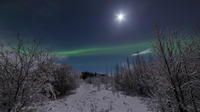Small-Group Aurora Borealis - Northern Lights Tour
Reykjavik, Iceland
Trip Type: Night Tours
Duration: 3 hours
Iceland has many spectacular, unforgettable natural sights. Probably the most famous are the magnificent Northern Lights, otherwise known as Aurora Borealis. This small-group tour by mini bus will be a trip you will never forget. During the winter time and far from the city lights, the dark Icelandic nights with the Northern lights dancing in the sky can take your breath away.
More About This Activity All Night Tours →
Iceland has many spectacular, unforgettable natural sights. Probably the most famous are the magnificent Northern Lights, otherwise known as Aurora Borealis. This small-group tour by mini bus will be a trip you will never forget. During the winter time and far from the city lights, the dark Icelandic nights with the Northern lights dancing in the sky can take your breath away.After a pick up from you hotel, travel with your small group outside of the city where the viewing is best. The lights are at their most frequent in late autumn to early spring, between the autumn equinox and spring equinox. The weather is also of importance, however, as September, October and November tend to be wet and snow-less in the north.
Beginning in December the weather dries up, and there is normally plenty of snow. During December and January, experience the long atmospheric evenings and very short days. In February and March the days grow longer and you will see more of the snow-clad landscapes during daytime.The evenings will still offer maximum chances to spot the Northern Lights. Your guide will take you to the best viewing spots they can find.
No guarantee can be given, though. Some weeks, you are treated to fantastic displays, repeated several times during the evening. At other times, there is densely falling snow and the lights simply stay away. Naturally, the longer you stay and the more time you set aside, the better the odds.
Beginning in December the weather dries up, and there is normally plenty of snow. During December and January, experience the long atmospheric evenings and very short days. In February and March the days grow longer and you will see more of the snow-clad landscapes during daytime.The evenings will still offer maximum chances to spot the Northern Lights. Your guide will take you to the best viewing spots they can find.
No guarantee can be given, though. Some weeks, you are treated to fantastic displays, repeated several times during the evening. At other times, there is densely falling snow and the lights simply stay away. Naturally, the longer you stay and the more time you set aside, the better the odds.
« Go Back

